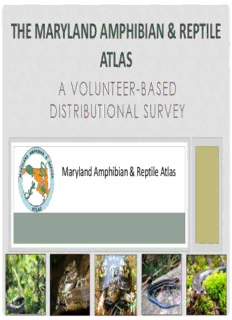
THE MARYLAND AMPHIBIAN & REPTILE ATLAS - The Coastal PDF
Preview THE MARYLAND AMPHIBIAN & REPTILE ATLAS - The Coastal
THE MARYLAND AMPHIBIAN & REPTILE ATLAS A VOLUN TEER - BA SED D IST RIBUT ION A L SURVEY Maryland Amphibian & Reptile Atlas GLOBAL DECLINE OF AMPHIBIANS & REPTILES • Amphibians 30% • Salamanders 49% • Frogs 29% • Reptiles 21% • Turtles 62% • Snakes & Lizards 21% • B irds 12.3% • Mammals 26% 2010 Source: IUCN 2010 Red List Summary Statistics http://www.iucnredlist.org/documents/summarystatistics/2010_4RL_Stats_Table_4a.pdf AMPHIBIAN & REPTILE DIVERSITY Map of Amphibian Diversity Map of Reptile Diversity Global = 6,600+ species Global = 6,000+ species US = ~295 species US = ~316 species MD = 41 species MD = 52 species REPTILE DIVERSITY Tortoise & Freshwater Turtle Distribution (from Peter Paul van Dijk, Conservation International) 320 turtle species world-wide 57 (20% of the world's turtle species) are found in the US and Canada Amphibians and reptiles face serious conservation pressures. Knowledge of current distribution patterns is vital for long-term conservation of amphibians and reptiles. Photographs by Heather Cunningham MARYLAND AMPHIBIAN & REPTILE ATLAS • Co-sponsors • Natural History Society of Maryland • Maryland Department of Natural Resources • Last publication on the distribution of Maryland’s herpetofauna was published in 1975 Photograph by Lance Benedict GOALS • Document the statewide distribution of Maryland’s amphibians and reptiles using a systematic and repeatable approach • Find rare species locations for future conservation efforts • Raise public awareness about the importance and value of this group of organisms 1983-1987 2002-2006 COORDINATION Steering Committee Lower Shore Herp Atlas Statewide training session Coordinator Annual Meeting County Coordinators SURVEY METHODS • Grid-based system using U.S. Geological Survey 7.5 minute quadrangles with each divided into six blocks. • 260 Quads & 1,441 blocks (1,293 land blocks) Google Earth Smartphone App
Description: